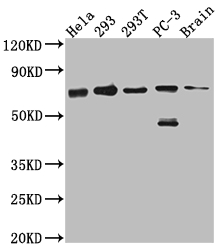The production of the LTA4H recombinant monoclonal antibody is a complex process that involves several stages. Initially, the LTA4H monoclonal antibody is harvested and its gene sequence is determined. Then, a vector carrying the LTA4H monoclonal antibody gene is designed and transfected into a host cell line for culturing. During the LTA4H monoclonal antibody synthesis, a synthesized peptide based on human LTA4H is used as an immunogen. The LTA4H recombinant monoclonal antibody is then purified using affinity chromatography. Finally, the specificity of the LTA4H monoclonal antibody is evaluated using ELISA and WB assays to ensure that it is capable of recognizing its target. It reacts with human and mouse LTA4H proteins.
The LTA4H protein is an enzyme that belongs to the epoxide hydrolase family, and its activity is crucial in the biosynthesis of leukotrienes and lipoxins, which are potent lipid mediators involved in inflammation and immune responses. LTA4H plays a crucial role in regulating the inflammatory response in cells by catalyzing the conversion of LTA4 to either LTB4 or LXA4. LTA4H also plays a role in regulating the immune response by modulating the activation and differentiation of immune cells. LTA4H is also involved in regulating immune cell activation and differentiation, wound healing, and cancer development and progression.




